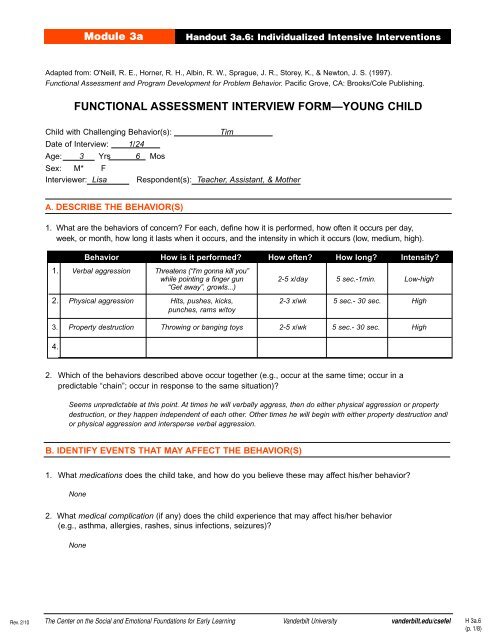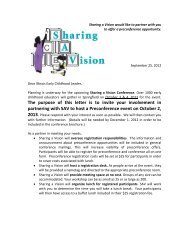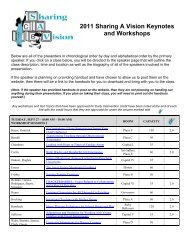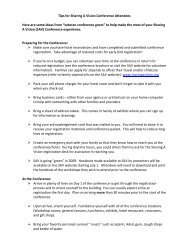FUNCTIONAL ASSESSMENT INTERVIEW FORM—YOUNG CHILD
functional assessment interview form—young child - Center on the ...
functional assessment interview form—young child - Center on the ...
- No tags were found...
Create successful ePaper yourself
Turn your PDF publications into a flip-book with our unique Google optimized e-Paper software.
Module 3aHandout 3a.6: Individualized Intensive InterventionsAdapted from: O'Neill, R. E., Horner, R. H., Albin, R. W., Sprague, J. R., Storey, K., & Newton, J. S. (1997).Functional Assessment and Program Development for Problem Behavior. Pacific Grove, CA: Brooks/Cole Publishing.<strong>FUNCTIONAL</strong> <strong>ASSESSMENT</strong> <strong>INTERVIEW</strong> <strong>FORM—YOUNG</strong> <strong>CHILD</strong>Child with Challenging Behavior(s):TimDate of Interview: 1/24Age: 3 Yrs 6 MosSex: M* FInterviewer: Lisa Respondent(s): Teacher, Assistant, & MotherA. DESCRIBE THE BEHAVIOR(S)1. What are the behaviors of concern? For each, define how it is performed, how often it occurs per day,week, or month, how long it lasts when it occurs, and the intensity in which it occurs (low, medium, high).1. Verbal aggression Threatens (“I'm gonna kill you”while pointing a finger gun 2-5 x/day 5 sec.-1min. Low-high“Get away”, growls...)2. Physical aggression Hits, pushes, kicks, 2-3 x/wk 5 sec.- 30 sec. Highpunches, rams w/toy3. Property destruction Throwing or banging toys 2-5 x/wk 5 sec.- 30 sec. High4.Behavior How is it performed? How often? How long? Intensity?2. Which of the behaviors described above occur together (e.g., occur at the same time; occur in apredictable “chain”; occur in response to the same situation)?Seems unpredictable at this point. At times he will verbally aggress, then do either physical aggression or propertydestruction, or they happen independent of each other. Other times he will begin with either property destruction and/or physical aggression and intersperse verbal aggression.B. IDENTIFY EVENTS THAT MAY AFFECT THE BEHAVIOR(S)1. What medications does the child take, and how do you believe these may affect his/her behavior?None2. What medical complication (if any) does the child experience that may affect his/her behavior(e.g., asthma, allergies, rashes, sinus infections, seizures)?NoneRev. 2/10The Center on the Social and Emotional Foundations for Early Learning Vanderbilt University vanderbilt.edu/csefel H 3a.6(p. 1/8)
Module 3aHandout 3a.6: Individualized Intensive Interventions3. Describe the sleep cycles of the child and the extent to which these cycles may affect his/her behavior.His mother reports that now that he is in school a routine is better established and will sleep through the night.Although she also reports that getting him to “go to bed” is very difficult and that he falls asleep on the coucharound 9:00 or 9:30 and is carried to his crib. Then, he sleeps very restlessly and is all over the bed. (Did not sleepthrough the night until he was 2.5 years.)4. Describe the eating routines and diet of the child and the extent to which these routines may affect his/herbehavior.Eats independently at school for snack. At home, his mother reports that “he is very explicit with getting food cutup,” and that “he sees food as a temporary interruption of play and only eats to live.” He sits in a high chair whileshe feeds him. Won't sit in restaurants to eat.5. Briefly list the child's typical daily schedule of activities and how well he/she does within each activity.Time Activity Child’s Reaction8:00 AM Wakes, gets dress, eats breakfast Better the last 2 wks - month, in the past, has physically resisteddressing and eating.8:30 AM To school Does nicely8:45 AM Arrives to school Greets by shooting with his finger gun, sometimes cries for hugUntil 9:30 AM Playground Verbal and physical aggression, property destruction9: 30 AM Story Time Sits and attends nicely9: 45 AM Small Group Sits and attends nicely10:00 AM Wiggle Time Follows directions and enjoys movement and dancing10:15 AM Plan/Centers Plans nicely, once in centers: verbal & physical aggression,property destruction10:30 AM Centers/Snack (cont.) Eats snack and plays computer nicely, other center areas, especiallyblocks, he will use verbal and physical aggression, property destruction11:30 AM Circle Sits and attends nicely11:45 AM Playground Verbal and physical aggression, property destruction12:30 PM Lunch Eats nicely1:00 PM Nap Lays on a cot nicely with book2:15 PM Snack Eats nicely2:35 PM Good-bye circle Sits, attends3:00 PM Mother picks up Goes nicely3:30 PM Then, the schedule is not consistent.(sometimes out shopping or home, Likes to stay busyGoes to mall or Target or home toplay or sometimes the park)Drives homeGoes nicely5:30 PM Arrives at home, plays on floor Enjoys6:00 PM Cont. playing Does O.K.6:30 PM Dad home/Dinner Picky, resistant, in high chair7:00 PM Play Chooses activities, sometimes rough with toys9:00 PM Bath Difficult to get out, gets physically aggressiveRev. 2/10 The Center on the Social and Emotional Foundations for Early Learning Vanderbilt University vanderbilt.edu/csefel H 3a.6(P. 2/8)
Module 3aHandout 3a.6: Individualized Intensive Interventions6 Describe the extent to which you believe activities that occur during the day are predictable for your child.To what extent does the child know what he/she will be doing and what will occur during the day(e.g., when to get up, when to eat breakfast, when to play outside)? How does your child know this?Both family and school feel that his schedule is predictable because they follow the same schedule every day.7. What choices does the child get to make each day (e.g., food, toys, activities)?At school child chooses activities outside and during centers, snack, play partners. At home food, afternoon activities,and chooses to behave.C. DEFINE EVENTS AND SITUATIONS THAT MAY TRIGGER BEHAVIOR(S)1. Time of Day: When are the behaviors most and least likely to happen?Most likely: - Centers, playground, and between 8:45-9:30 at night during bedtime, and when he is waiting for food atrestaurantsLeast likely: - In the morning at home and during circle, story, small group, structured activities2. Settings: Where are the behaviors most and least likely to happen?Most likely: - Playground with train or bikes or a new toy and in Centers in blocks, and in the housekeeping centerLeast likely: - Story time, wiggle time, planning, small group, and out in public (but occasionally will “get out ofcontrol”) and with snacks (His Mother reports that she will “feed him fun snacks to get him to behave.”)3. Social Control: With whom are the behaviors most and least likely to happen?Most likely: - With teacher or with someone who does not know him (substitute teacher) and MomLeast likely: - With team teacher next door.4. Activity: What activities are most and least likely to produce the behaviors?Most likely: - With a highly preferred item or activity or a novel activity, blocks/cars/magnetic people, with family,during outings (with new and different places, especially restaurants), and with change in routine.Least likely: - Quiet time, story time, at home—when he is playing alone and doing what he wants.5. Are there particular situations, events, etc., that are not listed above that “set off” the behaviors that causeconcern (particular demands, interruptions, transitions, delays, being ignored, etc.)?(Note: still in diapers, will indicate when soiled and needing to be changed. Often after bowel movement, seems agitated.)6. What one thing could you do that would most likely make the challenging behavior occur?Take a preferred toy away or remove him from computer. Mother reports that he will become angry and aggressiveif she changes her response to him or ignores him. She says, “He likes to have total control over his mother.”7. What one thing could you do to make sure the challenging behavior did not occur?Do not set limits. Let him have whatever he wants. Sit and give him one-on-one attention and talk to him. Motherreports - if you let him do whatever he wants, play by his rules, do what he says, and do no change anything.Rev. 2/10The Center on the Social and Emotional Foundations for Early Learning Vanderbilt University vanderbilt.edu/csefel H 3a.6(P. 3/8)
Module 3aHandout 3a.6: Individualized Intensive InterventionsD. DESCRIBE THE <strong>CHILD</strong>'S PLAY ABILITIES AND DIFFICULTIES1. Describe how your child plays (With what? How often?).Solitary play in dress-up and sometimes at computer. Parallel play at blocks, water table, and science area. Athome, plays alone with trucks, planes, trains, puzzles, books, and computer.2. Does your child have challenging behavior when playing? Describe.Computer and dress-up, usually plays nicely, but during outside play and blocks (cars, trucks, magnetic bendablepeople, legos, blocks, bright builders...) he will get aggressive if he sees something he wants, if he wants to joinother's play, if a child takes his toy or a piece of his toy, or he perceives a child is going to take his toy.When playing with neighborhood friends, the same occurs.3. Does your child play alone? What does he/she do?Yes, he prefers it.4. Does your child play with adults? What toys or games?Yes, school reports that he craves one-on-one adult attention. At home he wants to play with mom with everything.With dad, he will play rough and he is tolerant of the roughness.5. Does your child play with other children his/her age? What toys or games?Yes, one boy in particular at school and the boy will give in to Tim and try to “fix” situations when he becomesaggressive with others by telling the kids to give him the toy or by giving Tim a duplicate toy. Occasionally, he willplay with neighborhood friends (one boy and one girl his age), but he needs to be closely monitored because theywill be aggressive with one another. Plays with trucks, cars, trains, and planes.6. How does your child react if you join in a play activity with him/her?He's fine at both school and home as long as you do not change or alter what he is doing.7. How does your child react if you stop playing with him/her?He's fine at both school and home.8. How does your child react if you ask him/her to stop playing with a toy and switch to a different toy?At school he does not like it. He would want to negotiate more time, give reasons why, and tell you he is notfinished. At home he does not transition well; says “no” or “just a minute.”Rev. 2/10The Center on the Social and Emotional Foundations for Early Learning Vanderbilt University vanderbilt.edu/csefelH 3a6(P. 4/8)
Module 3aHandout 3a.6: Individualized Intensive InterventionsE. IDENTIFY THE “FUNCTION” OF THE CHALLENGING BEHAVIOR(S)1. Think of each of the behaviors listed in Section A, and define the function(s) you believe the behaviorserves for the child (i.e., what does he/she get and/or avoid by doing the behavior?)Behavior1.Verbal aggressionWhat does he/she get? Or What exactly does he/she avoid?Children react and then leave him alone and/or adult attention2. Physical aggression Gets a toy or activity or avoids group play or avoids transitions3. Property destruction Gets a toy or activity, children run away or back off4.5.6.7.8.9.10.2. Describe the child's most typical response to the following situations:a. Are the above behavior(s) more likely, less likely, or unaffected if you present him/her with a difficult task?More likelyb. Are the above behavior(s) more likely, less likely, or unaffected if you interrupt a desired event(eating ice cream, watching a video)?More likelyc. Are the above behavior(s) more likely, less likely, or unaffected if you deliver a “stern”request/command/reprimand?More likely at home, less likely with stern short command at school.d. Are the above behavior(s) more likely, less likely, or unaffected if you are present but do not interact with(ignore) the child for 15 minutes.More likelye. Are the above behavior(s) more likely, less likely, or unaffected by changes in routine?More likelyf. Are the above behavior(s) more likely, less likely, or unaffected if something the child wants is presentbut he/she can't get it (i.e., a desired toy that is visible but out of reach)?More likelyg. Are the above behavior(s) more likely, less likely, or unaffected if he/she is alone (no one else is present)?Less likelyRev. 2/10 The Center on the Social and Emotional Foundations for Early Learning Vanderbilt University vanderbilt.edu/csefel H 3a.6(P. 5/8)
Module 3aHandout 3a.6: Individualized Intensive InterventionsF. HOW WELL DOES THE BEHAVIOR WORK?1. What amount of physical effort is involved in the behaviors (e.g., prolonged intense tantrums vs. simple verbaloutbursts, etc.)?If “verbal negotiation” is not successful, he will be physically aggressive, and then it takes much physical effort tohold him. At home, they give him what he wants to avoid physical effort although he will kick, hit, and throw toys atadults. If escalated, it can last up to 15 minutes.2. Does engaging in the behaviors result in a “payoff” (getting attention, avoiding work) every time?Almost every time? Once in a while?Almost every time3. How much of a delay is there between the time the child engages in the behavior and gets the “payoff”?Is it immediate, a few seconds, longer?A few seconds, if he does something like crashes a tower or steps on a finger, then the children react and an adultmoves in.G. HOW DOES THE <strong>CHILD</strong> COMMUNICATE?1. What are the general expressive communication strategies used by or available to the child? (e.g., vocalspeech, signs/gestures, communication books/boards, electronic devices, etc.) How consistently are thestrategies used?Very verbal. At home he tries to negotiate everything.2. If your child is trying to tell you something or show you something and you don't understand, what willyour child do? (repeat the action or vocalization? modify the action or vocalization?)At school he seems to be understood. At home, he will try to explain it to you then start screaming.Rev. 2/10The Center on the Social and Emotional Foundations for Early Learning Vanderbilt University vanderbilt.edu/csefel H 3a.6(P. 6/8)
Module 3aHandout 3a.6: Individualized Intensive Interventions3. Tell me how your child expresses the following:MEANSFUNCTIONSGRAB & REACHGIVEPOINTLEADGAZE SHIFTMOVE TO YOUMOVE AWAY FROM YOUHEAD NOD/HEAD SHAKEFACIAL EXPRESSIONVOCALIZEIMMEDIATE ECHODELAYED ECHOCREATIVE SINGLE WORDCREATIVE MULTI WORDSIMPLE SIGNSCOMPLEX SIGNSSELF-INJURYAGGRESSIONTANTRUMCRY OR WHINEOTHERNONERequests an ObjectXRequests an ActionXXProtests or EscapesXXRequests HelpXXRequests a Social RoutineXRequests ComfortXXIndicates IllnessXXShows You SomethingX4. With regard to receptive communication ability:a. Does the child follow verbal requests or instructions? If so, approximately how many? (List, if only a few).Yes, he doesn't have problems with this. Good language skills.b. Is the child able to imitate someone demonstrating how to do a task or play with a toy?Excellent independent play. Imitates well.c. Does the child respond to sign language or gestures? If so, approximately how many? (List, if only a few.)N/Ad. How does the child tell you “yes” or “no” (if asked whether he/she wants to do something, go somewhere, etc.)?VerballyRev. 2/10The Center on the Social and Emotional Foundations for Early Learning Vanderbilt University vanderbilt.edu/csefel H 3a.6(P. 7/8)
Module 3aHandout 3a.6: Individualized Intensive InterventionsH. EXPLAIN <strong>CHILD</strong>’S PREFERENCES AND PREVIOUS BEHAVIOR INTERVENTIONS1. Describe the things that your child really enjoys. For example, what makes him/her happy? What might someonedo or provide that makes your child happy?At school—computer, outside push toys, train, trucks, adult one-to-one interaction, talking about howthings work and why things happen.At home—any kind of interaction with mommy or daddy especially floor time (cars, crash 'em games).2. What kinds of things have you or your child's care providers done to try and change the challenging behaviors?At school—Explicit rules, started 5 day attendance, anticipate negative behaviors, warnings with transitions.At home—Rules given before outings, if rules not followed, they leave, snacks in stores when he starts gettingaggressive, school 5 days a week.I. DEVELOP SUMMARY STATEMENTS FOR EACH MAJOR TRIGGER AND/OR CONSEQUENCEDistant Setting Immediate Antecedent Problem Behavior Maintaining FunctionEvent (Trigger) ConsequencesRev. 2/10 The Center on the Social and Emotional Foundations for Early Learning Vanderbilt University vanderbilt.edu/csefel H 3a.6(P. 8/8)





